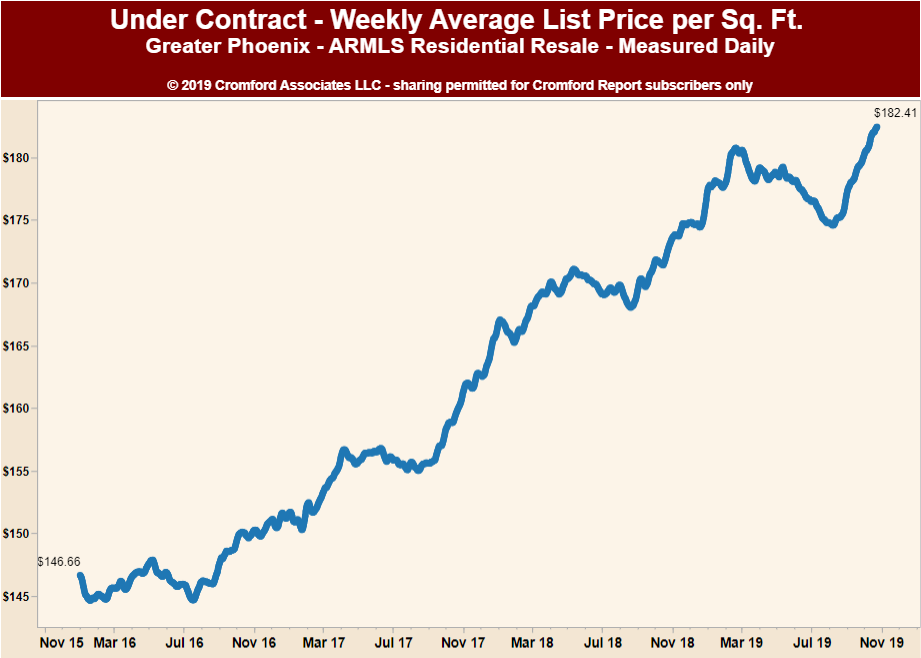As we head towards the end of the year, the market seasonally follows a pattern that tends to favor buyers. Typically between September and  December, active listings grow as demand cools. This year is no exception – although the impact is a gentle one at the moment.
December, active listings grow as demand cools. This year is no exception – although the impact is a gentle one at the moment.
2019 was an interesting year. It began with the market heading towards balance – something we hadn’t seen in a while. But by the end of February, it reversed course and began to strengthen on the seller’s side. June, July, and October produced fewer new sellers coming to market. In fact October set records on the scarcity of new sellers. This dearth of new listings has kept the market favoring sellers, and the seasonal shift has only slightly mitigated that power.
Price
Typically the most interesting thing to real estate buyers and sellers alike, is price. Pricing is a trailing indicator as we have mentioned in the past – often responding 6 months or more to an imbalance of supply and demand. The first place pricing shows up is in list prices followed by pending sales. Price per sq. ft is a pretty reliable indicator. Notice in the chart below how the impact on pricing starts to show up mid – August, literally 6 months after the market shifted in favor of sellers.
As Michael Orr of the Cromford Report comments “This was looking weak during the second and third quarters but has perked up dramatically since August 7…. $181.97 is the highest we have seen since the bubble year of 2005.”
He further comments: “Price momentum is rising, and in normal markets this tends to bring the market closer to balance. It does this by giving sellers better reasons to sell and giving buyers greater affordability problems.” When will the market shift in to balance? That is anyone’s guess but 2020 could be the year.
Bubble
Like any financial market, real estate is subject to two key emotions – fear and greed. When pricing escalates the initial euphoria often gives way to unease. One can hardly blame residents who survived the valley’s market debacle for assuming rising prices equates a bubble. How does one accurately differentiate a bubble from a rising market? Again, Michael Orr provides succinct insight:
“Higher prices should encourage more sellers and discourages buyers which will eventually have a balancing effect on the market. If you ever see that higher prices encourage buyers to buy more, that’s when you have a bubble developing. This is what happened in 2004 and early 2005, but it is not happening now.”
We repeat, a bubble is not happening now. For those who like more in depth analysis of pricing, continue on with Tina Tamboer’s comments:
“The news media is filled with short-term predictions regarding the economy and how it will, or will not, affect real estate prices. It’s understandable for buyers to want their home to appreciate in value after they purchase, who doesn’t? However there is far too much attention paid to short-term influences and fluctuations these days and not enough attention paid to the long view. Real estate is a long-term investment for many people. Despite the euphoria of 2005-2007 and the nightmare of 2008-2011, on average homes are selling 81.6% higher today than they were in the year 2000. That’s an average appreciation rate of 4.3% per year over the course of 19 years. Smaller homes appreciated the most over time while larger homes appreciated the least. Homes under 1,000 sf have appreciated 122% since 2000, an average of 6.4% per year. Those between 1,000-2,000 sf appreciated 106%, an average of 5.6% per year. 2,000-3,000 sf appreciated 68% at 3.6% per year. 3,000-4,000 sf appreciated 49% at 2.6% per year and homes over 4,000 sf appreciated 11% at 0.6% per year.
In short, we are in a normal seller’s market. We expect to see prices rising throughout at least the first quarter of 2020 – if not longer. We will follow the numbers and keep you posted as they unveil.
We thank you for allowing us to assist you with your real estate needs in 2019. We consider it our duty to advise and inform our clients – whether that means buying, selling, or staying put. We wish you and those you love a very happy Holiday season. Here’s to a terrific 2020!
Russell & Wendy Shaw
(Mostly Wendy)